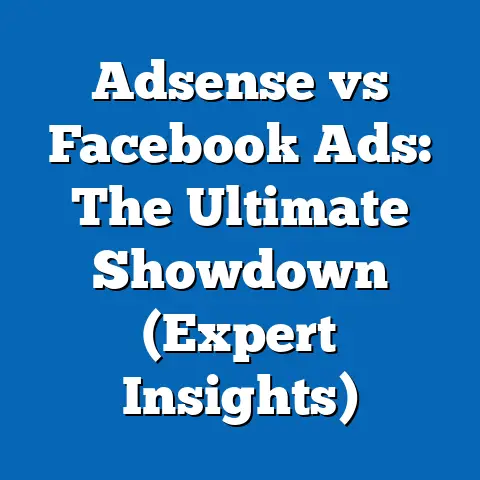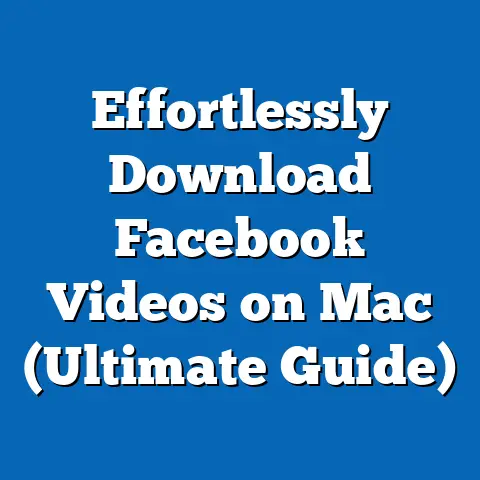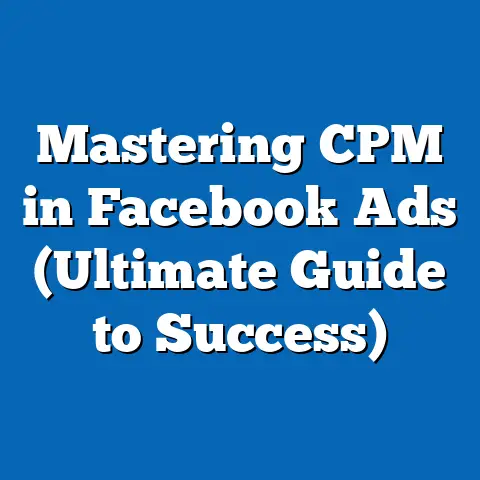Mastering Facebook Ad Budgets (Expert Strategies Revealed)
Imagine your Facebook ad budget as a meticulously crafted cake. Each layer—the campaign, the ad set, the individual ad—plays a vital role in the overall deliciousness, or in this case, the success of your marketing efforts. Neglect one layer, and the whole thing might crumble. In today’s hyper-competitive digital landscape, simply throwing money at Facebook ads isn’t enough. You need a well-structured, strategic budget that’s as nuanced as the audience you’re trying to reach.
I’ve seen countless businesses, from small startups to established brands, struggle with Facebook ad budgets. They often fall into the trap of either overspending with little to show for it, or underspending and missing out on valuable opportunities. That’s why I’m writing this guide – to demystify the process and equip you with the knowledge and strategies to truly master your Facebook ad budgets and achieve a significant ROI. We’ll peel back the layers, like an onion, revealing the secrets to effective allocation and optimization, ensuring every penny you spend contributes to your marketing goals. Let’s dive in!
Understanding the Basics of Facebook Ad Budgets
Before we start layering our budget like a pro, let’s cover the fundamentals. Facebook offers two primary budgeting options: daily and lifetime budgets. Understanding the difference is crucial for effective campaign management.
-
Daily Budget: This is the average amount you’re willing to spend each day on your ad set or campaign. Facebook will try to spend around this amount, but it might fluctuate slightly. On some days, you might spend a bit more, but over the course of a week, it will average out to your daily budget. This is great for campaigns that run continuously.
-
Lifetime Budget: This is the total amount you’re willing to spend over the entire duration of your campaign. Facebook will automatically optimize your spending to ensure you don’t exceed this limit. This is useful for campaigns with a specific end date, like promoting a limited-time offer or an event.
Daily Budget: This is the average amount you’re willing to spend each day on your ad set or campaign. Facebook will try to spend around this amount, but it might fluctuate slightly. On some days, you might spend a bit more, but over the course of a week, it will average out to your daily budget. This is great for campaigns that run continuously.
Lifetime Budget: This is the total amount you’re willing to spend over the entire duration of your campaign. Facebook will automatically optimize your spending to ensure you don’t exceed this limit. This is useful for campaigns with a specific end date, like promoting a limited-time offer or an event.
Choosing between the two depends on your campaign goals and timelines. If you want consistent exposure over an extended period, a daily budget is usually the way to go. If you have a specific event or promotion with a clear start and end date, a lifetime budget might be more suitable.
Beyond the budget type, it’s essential to understand how Facebook’s auction system works. When someone is eligible to see your ad, your bid (which is influenced by your budget) competes against other advertisers targeting the same audience. The higher your bid, the more likely your ad is to be shown. However, it’s not just about the highest bid. Facebook also considers ad quality and relevance to the user. This means you can win auctions even with a slightly lower bid if your ad is highly engaging and relevant to your target audience.
Ultimately, your budget decisions should always be driven by your campaign objectives. Are you trying to increase brand awareness, generate leads, or drive sales? Each objective requires a different approach to budgeting. For example, a brand awareness campaign might prioritize reach and frequency, while a lead generation campaign might focus on conversions and cost per lead.
Key Takeaway: Understanding the different budget types, how the auction system works, and aligning your budget with your campaign objectives are the foundational layers of a successful Facebook ad strategy.
Layering Your Budget Strategically
Now, let’s get to the heart of the matter: layering your budget strategically. Think of this as building your Facebook ad budget from the ground up, ensuring each layer is strong and contributes to the overall success. This involves allocating your budget across different levels: campaign, ad set, and ad.
-
Campaign Level Budgeting: This is where you define the overall goals of your advertising efforts. Are you running multiple campaigns with different objectives? For instance, you might have one campaign focused on brand awareness and another aimed at driving sales. The amount of budget you allocate to each campaign should reflect its importance in achieving your overall business goals. If sales are your top priority, you’ll likely allocate a larger portion of your budget to the sales-focused campaign.
I once worked with an e-commerce client who was launching a new product line. We created two campaigns: one for brand awareness and one for direct sales. Initially, we allocated equal budgets to both. However, after a week, we noticed that the sales campaign was performing significantly better, generating a high ROAS (Return on Ad Spend). We then adjusted the budget, allocating a larger portion to the sales campaign, which resulted in a substantial increase in overall revenue.
-
Ad Set Level Budgeting: Within each campaign, you’ll create ad sets to target specific audiences and placements. This is where you start to fine-tune your budget allocation. It’s crucial to test different audiences and placements to see what works best. This might involve creating multiple ad sets, each targeting a different demographic, interest group, or location.
For example, if you’re selling fitness apparel, you might create one ad set targeting people interested in yoga, another targeting those interested in running, and a third targeting weightlifters. The key is to distribute your budget among these ad sets and monitor their performance. The ad sets that are generating the best results should receive a larger portion of the budget.
Placement is also crucial. Facebook offers various placement options, including Facebook News Feed, Instagram Feed, Audience Network, and Messenger. Testing different placements can reveal which ones are most effective for reaching your target audience.
-
Ad Level Budgeting: Finally, within each ad set, you’ll have individual ads with different creative elements (images, videos, copy). Just like with ad sets, it’s essential to test different ad variations to see what resonates best with your audience.
This might involve creating multiple ads with different headlines, images, or calls to action. Allocate your budget across these ads and monitor their performance. The ads that are generating the highest engagement, click-through rates, and conversions should receive a larger portion of the budget.
I remember a campaign where we were promoting a new software product. We created several ads with different headlines, each highlighting a different benefit of the product. After analyzing the data, we discovered that the ad with the headline “Boost Your Productivity by 50%” significantly outperformed the others. We then reallocated the budget to prioritize that ad, resulting in a significant increase in sign-ups.
Campaign Level Budgeting: This is where you define the overall goals of your advertising efforts. Are you running multiple campaigns with different objectives? For instance, you might have one campaign focused on brand awareness and another aimed at driving sales. The amount of budget you allocate to each campaign should reflect its importance in achieving your overall business goals. If sales are your top priority, you’ll likely allocate a larger portion of your budget to the sales-focused campaign.
I once worked with an e-commerce client who was launching a new product line. We created two campaigns: one for brand awareness and one for direct sales. Initially, we allocated equal budgets to both. However, after a week, we noticed that the sales campaign was performing significantly better, generating a high ROAS (Return on Ad Spend). We then adjusted the budget, allocating a larger portion to the sales campaign, which resulted in a substantial increase in overall revenue.
Ad Set Level Budgeting: Within each campaign, you’ll create ad sets to target specific audiences and placements. This is where you start to fine-tune your budget allocation. It’s crucial to test different audiences and placements to see what works best. This might involve creating multiple ad sets, each targeting a different demographic, interest group, or location.
For example, if you’re selling fitness apparel, you might create one ad set targeting people interested in yoga, another targeting those interested in running, and a third targeting weightlifters. The key is to distribute your budget among these ad sets and monitor their performance. The ad sets that are generating the best results should receive a larger portion of the budget.
Placement is also crucial. Facebook offers various placement options, including Facebook News Feed, Instagram Feed, Audience Network, and Messenger. Testing different placements can reveal which ones are most effective for reaching your target audience.
Ad Level Budgeting: Finally, within each ad set, you’ll have individual ads with different creative elements (images, videos, copy). Just like with ad sets, it’s essential to test different ad variations to see what resonates best with your audience.
This might involve creating multiple ads with different headlines, images, or calls to action. Allocate your budget across these ads and monitor their performance. The ads that are generating the highest engagement, click-through rates, and conversions should receive a larger portion of the budget.
I remember a campaign where we were promoting a new software product. We created several ads with different headlines, each highlighting a different benefit of the product. After analyzing the data, we discovered that the ad with the headline “Boost Your Productivity by 50%” significantly outperformed the others. We then reallocated the budget to prioritize that ad, resulting in a significant increase in sign-ups.
Examples of Layered Budget Strategies:
-
E-commerce: Allocate the majority of your budget to ad sets targeting high-intent audiences (e.g., people who have visited your website or added items to their cart). Within those ad sets, test different product images and offers to see what drives the most sales.
-
Lead Generation: Focus your budget on ad sets targeting specific demographics or interest groups that are most likely to convert into leads. Within those ad sets, test different lead magnet offers (e.g., free e-books, webinars) to see what generates the most sign-ups.
-
Brand Awareness: Distribute your budget across a wider range of ad sets targeting broader audiences. Focus on creating engaging content that resonates with your target audience and helps build brand recognition.
E-commerce: Allocate the majority of your budget to ad sets targeting high-intent audiences (e.g., people who have visited your website or added items to their cart). Within those ad sets, test different product images and offers to see what drives the most sales.
Lead Generation: Focus your budget on ad sets targeting specific demographics or interest groups that are most likely to convert into leads. Within those ad sets, test different lead magnet offers (e.g., free e-books, webinars) to see what generates the most sign-ups.
Brand Awareness: Distribute your budget across a wider range of ad sets targeting broader audiences. Focus on creating engaging content that resonates with your target audience and helps build brand recognition.
Key Takeaway: A layered budget strategy involves allocating your budget across different levels (campaign, ad set, ad) and continuously monitoring and adjusting your spending based on performance data. This ensures that your budget is being used efficiently and effectively to achieve your marketing goals.
Advanced Budgeting Techniques
Once you’ve mastered the basics of layering your budget, you can start exploring advanced techniques to further optimize your spending. These strategies leverage Facebook’s powerful automation features and data-driven insights to maximize your ROI.
-
Dynamic Budgeting (Campaign Budget Optimization – CBO): This feature allows Facebook to automatically distribute your budget across ad sets within a campaign, based on real-time performance. Instead of manually setting budgets for each ad set, you set a single budget at the campaign level, and Facebook’s algorithm allocates the funds to the ad sets that are generating the best results.
CBO can be incredibly effective for campaigns with multiple ad sets targeting different audiences or placements. It allows Facebook to automatically shift your budget to the areas that are performing best, without you having to constantly monitor and adjust your spending.
However, it’s important to note that CBO works best when you have a sufficient amount of data. If your campaign is new or you have very small audiences, the algorithm might not have enough information to make accurate decisions.
I’ve seen CBO work wonders for clients who have complex campaigns with numerous ad sets. It saves them a significant amount of time and effort, while also improving their overall ROI.
-
Automated Rules: Facebook allows you to set automated rules that trigger specific actions based on predefined performance metrics. For example, you can create a rule that automatically increases the budget for an ad set if its cost per conversion falls below a certain threshold, or pauses an ad set if its cost per click exceeds a certain limit.
Automated rules are a powerful tool for managing your budget and optimizing your campaigns in real-time. They allow you to respond quickly to changes in performance and ensure that your budget is always being used efficiently.
I often use automated rules to prevent overspending on poorly performing ads or ad sets. For example, I might set a rule that automatically pauses any ad that has a CTR (Click-Through Rate) below a certain percentage after a certain number of impressions.
-
Seasonal Adjustments: Many businesses experience seasonal fluctuations in demand. For example, retailers often see a surge in sales during the holiday season, while travel companies might see increased demand during the summer months.
It’s crucial to adjust your Facebook ad budgets to account for these seasonal trends. During peak seasons, you might need to increase your budget to capture the increased demand. Conversely, during off-seasons, you might need to reduce your budget to avoid wasting money on ads that are unlikely to convert.
I worked with a client who sold outdoor furniture. They noticed a significant increase in sales during the spring and summer months. We adjusted their Facebook ad budget, increasing it by 50% during those months. This allowed them to capitalize on the increased demand and generate a significant increase in revenue.
Dynamic Budgeting (Campaign Budget Optimization – CBO): This feature allows Facebook to automatically distribute your budget across ad sets within a campaign, based on real-time performance. Instead of manually setting budgets for each ad set, you set a single budget at the campaign level, and Facebook’s algorithm allocates the funds to the ad sets that are generating the best results.
CBO can be incredibly effective for campaigns with multiple ad sets targeting different audiences or placements. It allows Facebook to automatically shift your budget to the areas that are performing best, without you having to constantly monitor and adjust your spending.
However, it’s important to note that CBO works best when you have a sufficient amount of data. If your campaign is new or you have very small audiences, the algorithm might not have enough information to make accurate decisions.
I’ve seen CBO work wonders for clients who have complex campaigns with numerous ad sets. It saves them a significant amount of time and effort, while also improving their overall ROI.
Automated Rules: Facebook allows you to set automated rules that trigger specific actions based on predefined performance metrics. For example, you can create a rule that automatically increases the budget for an ad set if its cost per conversion falls below a certain threshold, or pauses an ad set if its cost per click exceeds a certain limit.
Automated rules are a powerful tool for managing your budget and optimizing your campaigns in real-time. They allow you to respond quickly to changes in performance and ensure that your budget is always being used efficiently.
I often use automated rules to prevent overspending on poorly performing ads or ad sets. For example, I might set a rule that automatically pauses any ad that has a CTR (Click-Through Rate) below a certain percentage after a certain number of impressions.
Seasonal Adjustments: Many businesses experience seasonal fluctuations in demand. For example, retailers often see a surge in sales during the holiday season, while travel companies might see increased demand during the summer months.
It’s crucial to adjust your Facebook ad budgets to account for these seasonal trends. During peak seasons, you might need to increase your budget to capture the increased demand. Conversely, during off-seasons, you might need to reduce your budget to avoid wasting money on ads that are unlikely to convert.
I worked with a client who sold outdoor furniture. They noticed a significant increase in sales during the spring and summer months. We adjusted their Facebook ad budget, increasing it by 50% during those months. This allowed them to capitalize on the increased demand and generate a significant increase in revenue.
Case Studies and Anecdotes:
-
A clothing retailer used CBO to automatically distribute their budget across multiple ad sets targeting different demographics and interests. This resulted in a 20% increase in overall sales.
-
A lead generation company used automated rules to pause poorly performing ads and increase the budget for high-performing ads. This resulted in a 15% reduction in their cost per lead.
-
A travel agency adjusted their Facebook ad budget to increase spending during peak travel seasons and decrease spending during off-seasons. This resulted in a 10% increase in overall bookings.
A clothing retailer used CBO to automatically distribute their budget across multiple ad sets targeting different demographics and interests. This resulted in a 20% increase in overall sales.
A lead generation company used automated rules to pause poorly performing ads and increase the budget for high-performing ads. This resulted in a 15% reduction in their cost per lead.
A travel agency adjusted their Facebook ad budget to increase spending during peak travel seasons and decrease spending during off-seasons. This resulted in a 10% increase in overall bookings.
Key Takeaway: Advanced budgeting techniques like dynamic budgeting, automated rules, and seasonal adjustments can help you further optimize your Facebook ad spending and maximize your ROI. However, it’s important to use these techniques strategically and based on data-driven insights.
Monitoring and Adjusting Your Budget
Setting your budget is just the first step. The real magic happens in the monitoring and adjustment phase. Think of your budget as a living, breathing entity that needs constant care and attention.
Regularly monitoring your ad performance metrics is crucial for understanding how your budget is being used and identifying areas for improvement. Facebook Ads Manager provides a wealth of data that can help you track the effectiveness of your budget allocation.
Some key performance indicators (KPIs) to focus on include:
-
Cost Per Click (CPC): This is the amount you pay each time someone clicks on your ad. A high CPC might indicate that your targeting is too broad or your ad copy isn’t compelling.
-
Click-Through Rate (CTR): This is the percentage of people who see your ad and click on it. A low CTR might indicate that your ad isn’t relevant to your target audience or your creative isn’t engaging.
-
Cost Per Conversion (CPC): This is the amount you pay each time someone completes a desired action, such as making a purchase, signing up for a newsletter, or filling out a lead form. A high CPA might indicate that your landing page isn’t optimized for conversions or your targeting is off.
-
Return on Ad Spend (ROAS): This is the amount of revenue you generate for every dollar you spend on advertising. A high ROAS indicates that your advertising is highly effective.
Cost Per Click (CPC): This is the amount you pay each time someone clicks on your ad. A high CPC might indicate that your targeting is too broad or your ad copy isn’t compelling.
Click-Through Rate (CTR): This is the percentage of people who see your ad and click on it. A low CTR might indicate that your ad isn’t relevant to your target audience or your creative isn’t engaging.
Cost Per Conversion (CPC): This is the amount you pay each time someone completes a desired action, such as making a purchase, signing up for a newsletter, or filling out a lead form. A high CPA might indicate that your landing page isn’t optimized for conversions or your targeting is off.
Return on Ad Spend (ROAS): This is the amount of revenue you generate for every dollar you spend on advertising. A high ROAS indicates that your advertising is highly effective.
By tracking these KPIs, you can identify areas where your budget is being used efficiently and areas where it’s being wasted. For example, if you notice that one ad set has a significantly higher CPC than another, you might need to adjust your targeting or improve your ad copy.
Regularly reviewing your data is essential for making informed decisions about your budget allocation. Don’t be afraid to experiment with different strategies and test new approaches. The key is to continuously learn and adapt based on the data.
Key Takeaway: Consistent monitoring of your ad performance metrics and a willingness to adjust your budget based on those insights are crucial for maximizing the effectiveness of your Facebook advertising.
Common Pitfalls to Avoid
Even with the best strategies in place, it’s easy to fall into common budgeting pitfalls. Being aware of these mistakes can help you avoid wasting money and maximize your ROI.
-
Underfunding Campaigns: One of the most common mistakes is not allocating enough budget to your campaigns. If you’re trying to reach a large audience or compete in a competitive market, you need to be willing to invest a significant amount of money. Underfunding your campaigns can result in low reach, poor engagement, and ultimately, a low ROI.
-
Failing to Adjust for Performance: Another common mistake is setting your budget and then forgetting about it. As we’ve discussed, it’s crucial to continuously monitor your ad performance and adjust your budget based on the data. Failing to do so can result in wasted spending and missed opportunities.
-
Ignoring Audience Overlap: If you’re targeting multiple audiences that overlap, you might be bidding against yourself. This can drive up your costs and reduce the effectiveness of your campaigns. Use Facebook’s Audience Overlap tool to identify overlapping audiences and adjust your targeting accordingly.
-
Not Testing Different Ad Variations: Testing different ad variations is crucial for identifying what resonates best with your target audience. Failing to do so can result in poor engagement and low conversion rates.
-
Ignoring Mobile Optimization: A significant portion of Facebook users access the platform on mobile devices. If your ads aren’t optimized for mobile, you’re likely missing out on a large segment of your target audience. Make sure your images and videos are optimized for mobile screens and your landing pages are mobile-friendly.
Underfunding Campaigns: One of the most common mistakes is not allocating enough budget to your campaigns. If you’re trying to reach a large audience or compete in a competitive market, you need to be willing to invest a significant amount of money. Underfunding your campaigns can result in low reach, poor engagement, and ultimately, a low ROI.
Failing to Adjust for Performance: Another common mistake is setting your budget and then forgetting about it. As we’ve discussed, it’s crucial to continuously monitor your ad performance and adjust your budget based on the data. Failing to do so can result in wasted spending and missed opportunities.
Ignoring Audience Overlap: If you’re targeting multiple audiences that overlap, you might be bidding against yourself. This can drive up your costs and reduce the effectiveness of your campaigns. Use Facebook’s Audience Overlap tool to identify overlapping audiences and adjust your targeting accordingly.
Not Testing Different Ad Variations: Testing different ad variations is crucial for identifying what resonates best with your target audience. Failing to do so can result in poor engagement and low conversion rates.
Ignoring Mobile Optimization: A significant portion of Facebook users access the platform on mobile devices. If your ads aren’t optimized for mobile, you’re likely missing out on a large segment of your target audience. Make sure your images and videos are optimized for mobile screens and your landing pages are mobile-friendly.
Key Takeaway: By being aware of these common budgeting pitfalls and taking steps to avoid them, you can significantly improve the effectiveness of your Facebook advertising and maximize your ROI.
Conclusion
Mastering Facebook ad budgets is not a one-time task, but an ongoing process of learning, testing, and optimizing. By adopting a layered approach to budgeting, leveraging advanced techniques, and continuously monitoring your performance, you can unlock the full potential of Facebook advertising and achieve your marketing goals.
Remember, your budget is not just a number; it’s a strategic tool that can be used to drive growth and achieve your business objectives. Take the time to understand the nuances of Facebook advertising and develop a budget strategy that aligns with your goals.
I’ve shared my insights and experiences, but the real learning comes from doing. Start experimenting with different budget strategies, track your results, and adjust your approach as needed. The more you practice, the better you’ll become at mastering your Facebook ad budgets.
Now it’s your turn. Take the knowledge you’ve gained from this guide and start implementing these strategies in your own campaigns. Don’t be afraid to experiment and learn from your mistakes. The key is to stay persistent and never stop optimizing. Your advertising success depends on it.
Call to Action
I’d love to hear about your experiences with Facebook ad budgeting. Share your own strategies, challenges, and successes in the comments below. And if you’re looking for more resources on Facebook advertising, be sure to check out Facebook’s official documentation and community forums. Together, we can all become masters of Facebook ad budgets!






